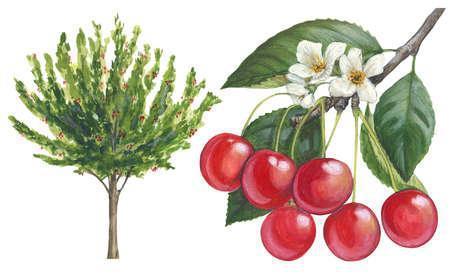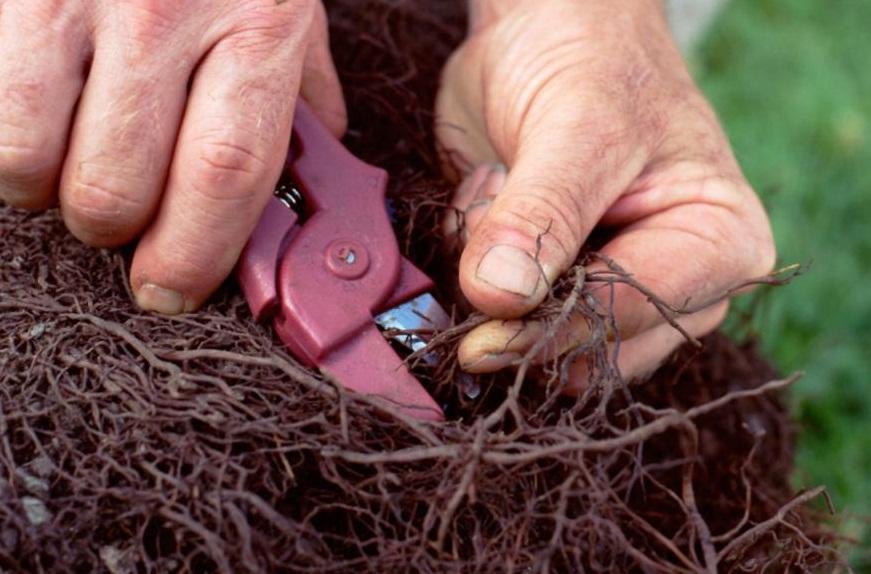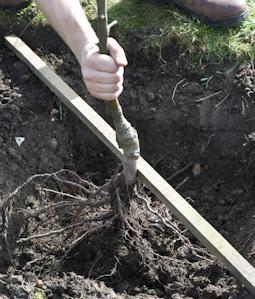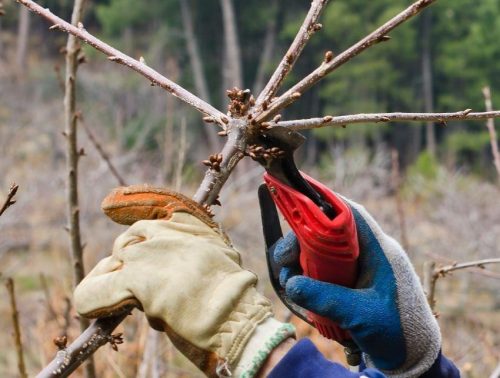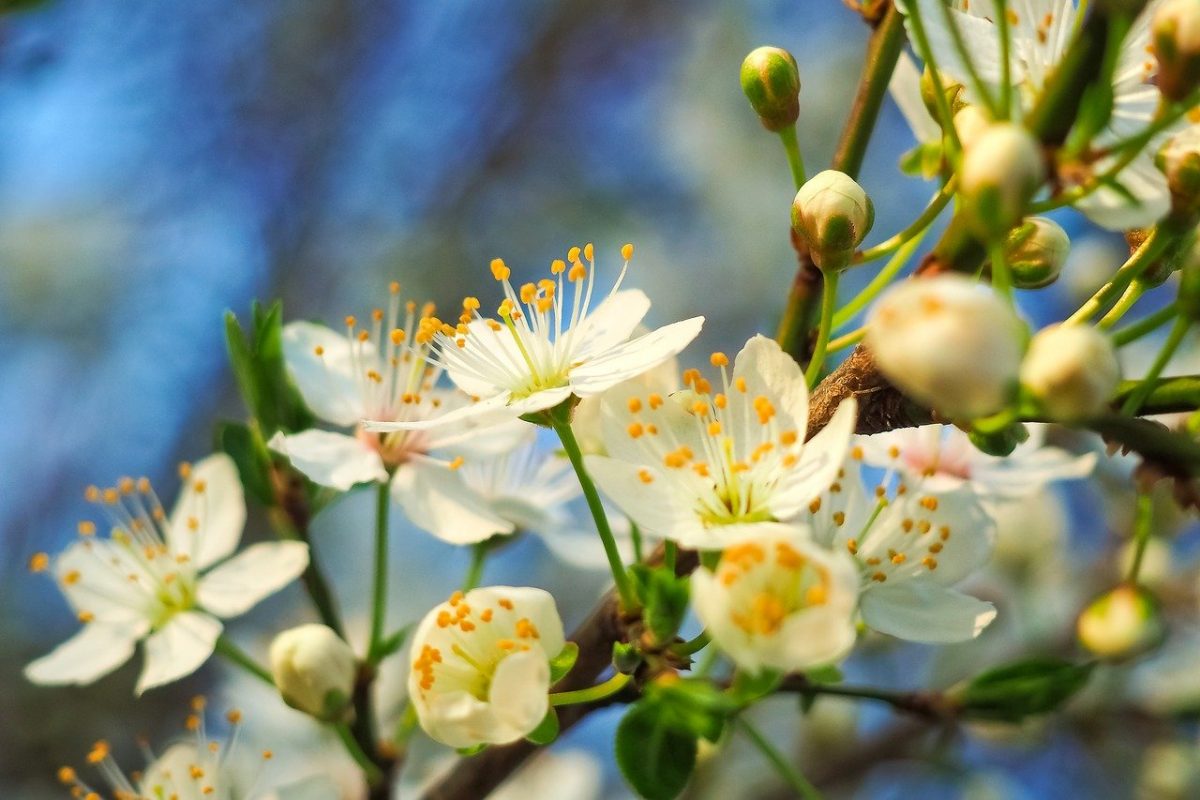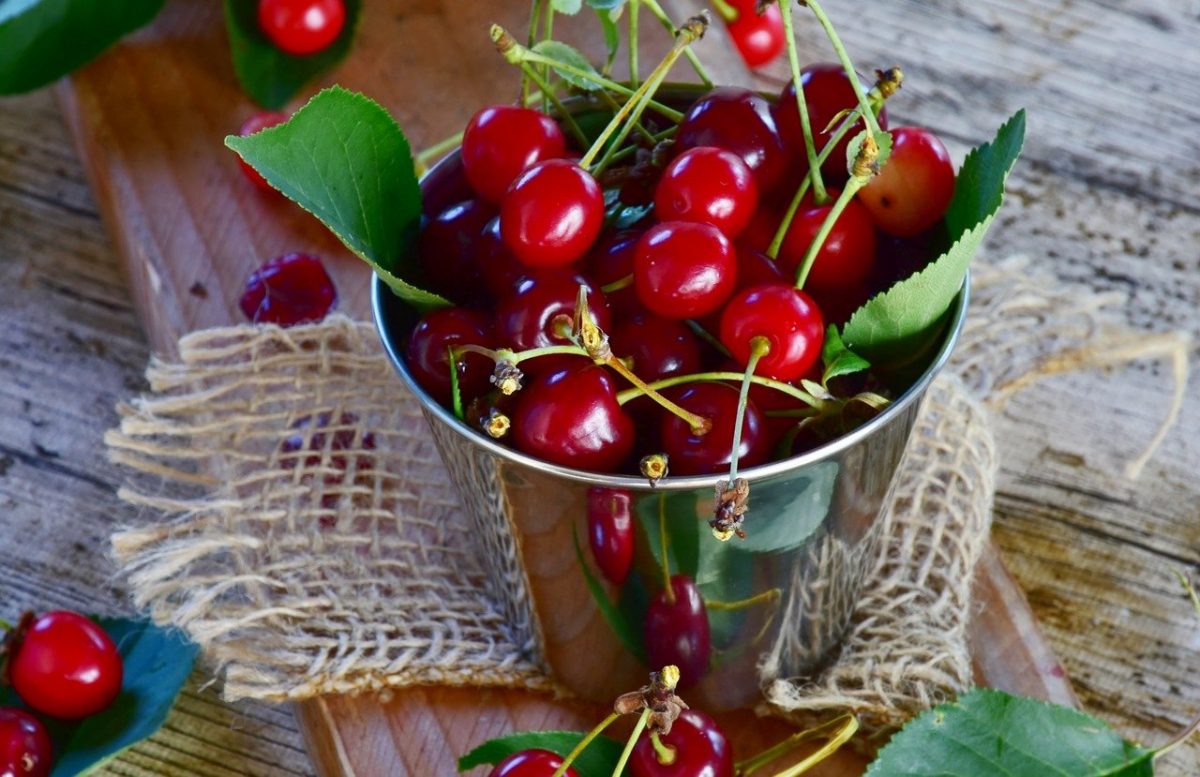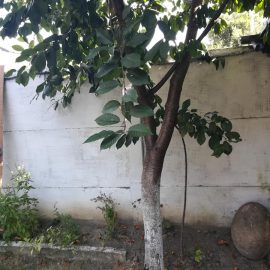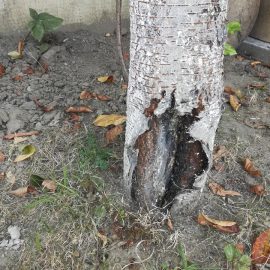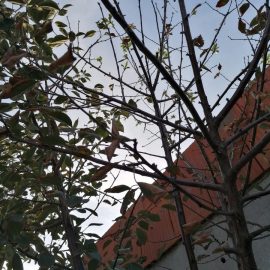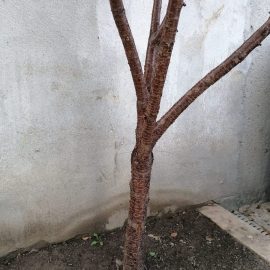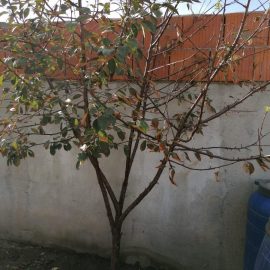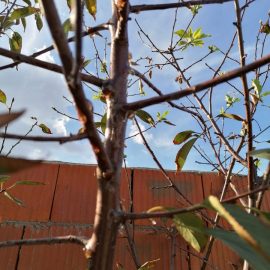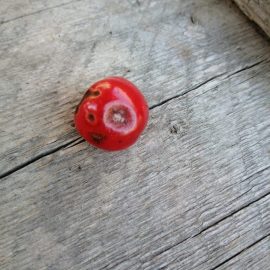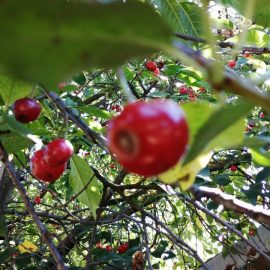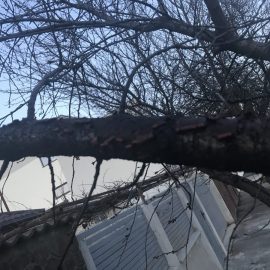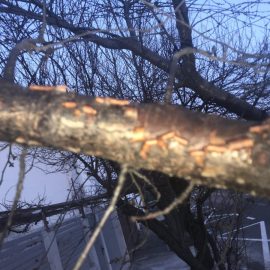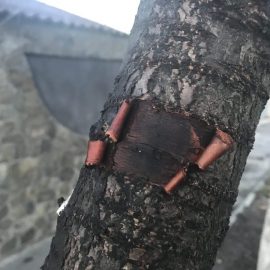Sour cherry, planting, growing and harvesting
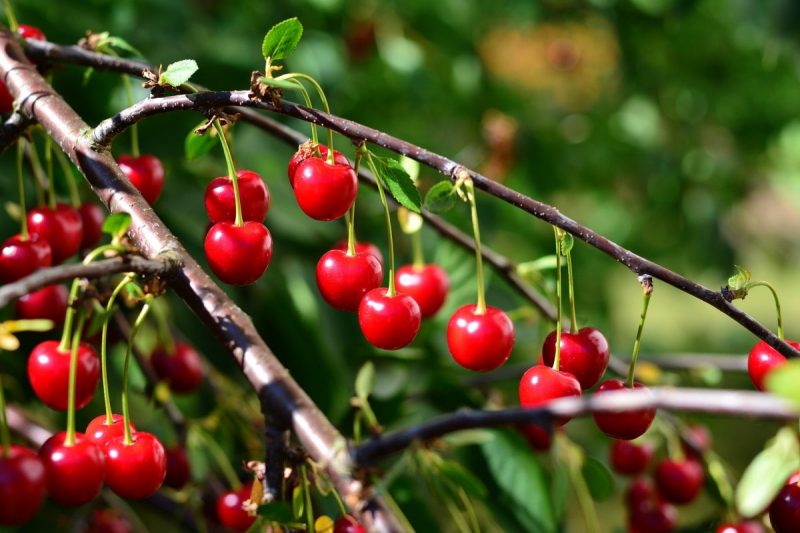
Sour cherry (Prunus cerasus) is a fruit tree native to Central Asia, prized for its fruit. It is a rustic species, which succeeds in most areas of culture, being also a good melliferous species. The tree has glossy, toothed leaves on the edge, and the flowers are white. Sour cherry fruits contain sugars, organic acids, proteins, pectins, potassium, phosphorus, calcium, magnesium, vitamins, and carotene.
Growing and fruiting particularities
The root system is poorly developed, most of the roots explore the soil to a depth of 40 cm. Compared to the cherry tree, the aerial part is small or medium in size. The branching capacity depends on the variety, and the growth rate is lower than on cherry trees.
Sour cherry blossoms after or at the same time as the cherry tree, but the pollination is different. Depending on the temperature, the flowering period is spread over 7-10 days. The varieties can be self-fertile, self-sterile, and intersterile groups. Pollination is entomophilic and cross-pollinated. In the orchard, it is recommended to plant at least 3 different varieties so that the pollination takes place normally (20-40% of the flowers must be pollinated). If the flowering period overlaps, pollination can also be done with the help of cherry tree varieties. The sour cherry bears fruits 2-3 years after planting, and the orchard longevity is 20-30 years (depending on the variety).
Climate and soil requirements
Compared to the cherry tree, sour cherry does not have high-temperature requirements. It thrives in areas with an average annual temperature of 8-11 °C. It is a very winter-hardy species. During the vegetative dormancy, it withstands temperatures down to -30 °C. The buds also withstand -12 °C, and the flowers withstand up to -2 °C.
Optimum temperatures fall in the 15-25°C range. Sour cherry tree yields well in areas where 500-700 mm of rain falls annually. It is very sensitive to excess moisture in the soil, which causes root suffocation. Due to the low light requirements, it makes good use of the slopes with northeast or northwest exposure. It does not tolerate heavy and compact soils, but it does well on thin, slightly eroded soils.
Soil preparation
The land must be chosen carefully to meet the pedoclimatic requirements. The plot must have a southern exposure and it must be well-leveled. The soil should be worked according to the general rules. If the plantation will be set up on land that has been used as an orchard, the soil is prepared 1-2 years in advance. To restore the soil structure and eliminate disease outbreaks, the land can be cultivated with perennial legumes. If the plot is heavily infested with weeds, you can apply non-selective herbicides.
Recommended products
-
You can find products on a different store
Change Store -
You can find products on a different store
Change Store -
You can find products on a different store
Change Store -
You can find products on a different store
Change Store -
You can find products on a different store
Change Store -
You can find products on a different store
Change Store -
You can find products on a different store
Change Store -
You can find products on a different store
Change Store -
You can find products on a different store
Change Store -
You can find products on a different store
Change Store -
You can find products on a different store
Change Store -
You can find products on a different store
Change Store -
You can find products on a different store
Change Store -
You can find products on a different store
Change Store -
You can find products on a different store
Change Store -
You can find products on a different store
Change Store -
You can find products on a different store
Change Store -
You can find products on a different store
Change Store -
You can find products on a different store
Change Store -
You can find products on a different store
Change Store -
You can find products on a different store
Change Store -
You can find products on a different store
Change Store -
You can find products on a different store
Change Store -
You can find products on a different store
Change Store
The soil should be fertilized with organic fertilizers (manure, compost). It is recommended to scarify the soil so that the tree roots can develop easily. All foreign matter in the soil should be collected and removed from the plot, after which the soil should be well-leveled.
For precise planting, the land can be picketed. Picketing is the process of marking the position of each sour cherry tree on the ground. Specifically, a stake is inserted into the tree planting site.
Planting
The best time to plant is in autumn, after leaf fall. Spring planting may be carried out only if autumn planting has not been successful. When establishing planting distances, take into account: the vigor of the rootstocks on which the trees are grafted, the shape of the crown, the vigor of the sour cherry varieties, and the soil fertility.
As a guideline, in the case of trees grafted on high-vigor rootstocks, it is recommended 5×4 m. For an intensive cultivation system, trees grafted on rootstocks of lower vigor, 4×3 m or 4×2 m, without tree support. The planting material should only be obtained from the authorized nursery.
Root trimming
The operation is performed to remove the damaged portions and to maintain a healthy root system. The necrotic roots should be completely removed, and the healthy ones should be shortened by 7-8 cm. Trimming can be done only if the planting material has been recently removed from the soil.
After trimming, the roots must be soaked. Mudding means dipping the root into a mixture of yellow soil, fresh manure, and water. The mud layer helps the tree to adapt to the new soil conditions and maintains the moisture around the roots.
Actual planting
This stage begins with digging the pit. If it is too small, the root system will develop slowly. The size of the pit will be influenced by the degree of soil looseness. If the soil has not been worked, the pit should be dug 2-3 months in advance and should have the following dimensions: 100 x 100 x 80 cm. If the land has been properly worked, the pit should be dug 1-2 days before or even the same day. In this case, the pit will have the following indicative dimensions: 40 x 40 x 40 cm.
The soil removed from the topside of the pit will be mixed with manure and placed at the base of the pit. Insert the sapling into the pit so that the root stays on the fertile layer. When planting, the roots must be in close contact with the soil. The grafting point of the tree should be 5-10 cm above the ground.
After planting, the soil should be well watered, and a stake should be placed next to the saplings to support them. The sour cherry trees can also be covered with rodent protection materials.
Care works
Saplings planted in autumn are sensitive in spring and need to be watered regularly. To maintain moisture, the soil around it should be shallowly dug and covered with a layer of mulch.
Sour cherry tree pruning
Pruning can be carried out from the first year of vegetation. They aim to achieve a balance between growth and fruiting. A tree that is properly pruned has a longer shelf life than an unpruned tree. The sour cherry tree crown should be formed so that the maintenance and harvesting works can be done as easily as possible.
Recommended products
-
You can find products on a different store
Change Store -
You can find products on a different store
Change Store -
You can find products on a different store
Change Store -
You can find products on a different store
Change Store -
You can find products on a different store
Change Store -
You can find products on a different store
Change Store -
You can find products on a different store
Change Store -
You can find products on a different store
Change Store -
You can find products on a different store
Change Store -
You can find products on a different store
Change Store -
You can find products on a different store
Change Store -
You can find products on a different store
Change Store -
You can find products on a different store
Change Store -
You can find products on a different store
Change Store -
You can find products on a different store
Change Store -
You can find products on a different store
Change Store -
You can find products on a different store
Change Store -
You can find products on a different store
Change Store -
You can find products on a different store
Change Store -
You can find products on a different store
Change Store -
You can find products on a different store
Change Store -
You can find products on a different store
Change Store -
You can find products on a different store
Change Store -
You can find products on a different store
Change Store
In the spring of the first year, the tree can be shortened to 80 cm above an outward-facing fruit bud. Once the tree has started to grow, all twigs in the trunk area should be removed up to a height of 50 cm. During the summer (August), pick 3-4 evenly spaced twigs to form the future crown.
In the spring of the second year, choose the main twigs. If they are longer than 60 cm, shorten them to the same length. The twig extending the main axis should be shortened to 25 cm higher than the main twigs.
In summer, remove all water sprouts and those growing on the upper part of the main branches (crown).
In the third year of growth, the extension branch of the main axis should be pruned above a side bud for branching. Choose a twig to form the second crown layer. These should be 60-70 cm above the first crown layer. The shoots growing on the upper part of the branches (crown) should be removed.
In the fourth year choose a twig to form the third layer of the crown. This should be 30 cm away from the second layer. Remove all water sprouts, competing or inward-facing twigs. Shorten 50 % of the annual branches to 4-5 buds (to normalize fruiting). In the following years, the pruning should limit the height of the tree and maintain the balance between growth and fruiting. Remove old (4-5 years old), diseased branches and those growing inside the crown.
Summer pruning
These prunings are easier to bear than those made in the dormant phase. First of all, remove broken, dry, or diseased branches and water sprouts. Remove branches that intersect or shade each other. Young twigs should be pinched off (cut off the tip). This stimulates bud differentiation and twigs branching. All pruning should be done diagonally. In this way, water drains easily from the wounds. Lesions larger than 2 cm must be covered with tree wound sealer.
Recommended products
-
You can find products on a different store
Change Store -
You can find products on a different store
Change Store -
You can find products on a different store
Change Store -
You can find products on a different store
Change Store -
You can find products on a different store
Change Store -
You can find products on a different store
Change Store -
You can find products on a different store
Change Store -
You can find products on a different store
Change Store -
You can find products on a different store
Change Store -
You can find products on a different store
Change Store -
You can find products on a different store
Change Store -
You can find products on a different store
Change Store -
You can find products on a different store
Change Store -
You can find products on a different store
Change Store -
You can find products on a different store
Change Store -
You can find products on a different store
Change Store -
You can find products on a different store
Change Store -
You can find products on a different store
Change Store -
You can find products on a different store
Change Store -
You can find products on a different store
Change Store -
You can find products on a different store
Change Store -
You can find products on a different store
Change Store -
You can find products on a different store
Change Store -
You can find products on a different store
Change Store
Fruiting stimulation
These operations stimulate the sour cherry tree to produce more fruit, to bear fruit faster, or to develop stronger shoots:
- Branch training: represents the change of natural position of the branches, towards the vertical. This causes the branch to grow and strengthen. This operation should carried out mainly in the mature phase of the trees. In this phase, the vegetative growth ceases and this operation leads to the rejuvenation of the tree crown.
- Branch tying down: it consists in changing the position of the branches, towards the horizontal. This causes the fruit buds on the branch to grow and aerates the crown. Branches can be tied down below the horizontal to obtain abundant fruiting. This operation is practiced in the young stage of the trees when vegetative growth is predominant.
- Branch arching: through this change of position, the basal part remains ascending, and the terminal part is inclined below the horizontal (descent). This operation stops or slows down the growth in length of the branch and promotes bud growth. Trees that have been arched begin to bear fruit 2-3 years earlier.
- Transverse incision: represents the disruption of the vessels by a fine cut with a sharp blade. The cut must be made above a bud.
- Longitudinal incision: represents a fine cut along the length of the trunk. This operation helps to increase the thickness of the trunk.
- Twisting: consists of twisting a branch or twig. This operation stimulates fruiting.
- Branch breaking: it is practiced in the case of branches that have an inappropriate orientation. Fruiting occurs quickly on broken branches.
Sour cherry tree maintenance
The sour cherry orchard maintenance is differentiated, depending on the area and the age of the plantation. Under irrigation conditions, you can grow vegetables or fruit shrubs between rows. Examples: tomatoes, peppers, eggplant, onions, garlic, potatoes, strawberries, etc. In areas where the soil is affected by erosion, the space between the rows should be sown with grass or used for fodder production (hay, alfalfa, etc.). In dry areas, the soil must be tilled to accumulate as much water as possible. It is possible to apply herbicides, but only 2-3 years after planting.
Recommended products
-
You can find products on a different store
Change Store -
You can find products on a different store
Change Store -
You can find products on a different store
Change Store -
You can find products on a different store
Change Store -
You can find products on a different store
Change Store -
You can find products on a different store
Change Store -
You can find products on a different store
Change Store -
You can find products on a different store
Change Store -
You can find products on a different store
Change Store -
You can find products on a different store
Change Store -
You can find products on a different store
Change Store -
You can find products on a different store
Change Store -
You can find products on a different store
Change Store -
You can find products on a different store
Change Store -
You can find products on a different store
Change Store -
You can find products on a different store
Change Store -
You can find products on a different store
Change Store -
You can find products on a different store
Change Store -
You can find products on a different store
Change Store -
You can find products on a different store
Change Store -
You can find products on a different store
Change Store -
You can find products on a different store
Change Store -
You can find products on a different store
Change Store -
You can find products on a different store
Change Store
Irrigation
Irrigation is necessary in areas with a rainfall deficit to ensure high yields and good tree growth. The critical times for water are the bud differentiation phase (bud swelling), the flowering phase, and the fruit growth phase. Irrigation is recommended whenever necessary to ensure constant soil moisture. It can be effectively irrigated both by drip and micro-sprinkling.
Protecting sour cherry tree from frost
When low temperatures are announced, in the orchard, you can burn easily burning materials (gathered in piles), which produces a large amount of smoke (rubber, straw, manure, tar, peat, etc.). Thus, the smoke layer that forms above the orchard does not allow heat to be released from the soil and thus maintains a higher temperature at the trunk/tree crown level. It is important to keep the fire on throughout the night, especially before sunrise, when temperatures drop sharply. This operation can protect the trees from temperatures down to -3 °C.
Fertilization
Young sour cherry trees should be fertilized with manure applied every 2-3 years or with chemical fertilizers (NPK type) applied annually. For young plantations, apply fertilizer at the base of the tree. Trees also respond well to foliar fertilizers.
Recommended products
-
You can find products on a different store
Change Store -
You can find products on a different store
Change Store -
You can find products on a different store
Change Store -
You can find products on a different store
Change Store -
You can find products on a different store
Change Store -
You can find products on a different store
Change Store -
You can find products on a different store
Change Store -
You can find products on a different store
Change Store -
You can find products on a different store
Change Store -
You can find products on a different store
Change Store -
You can find products on a different store
Change Store -
You can find products on a different store
Change Store -
You can find products on a different store
Change Store -
You can find products on a different store
Change Store -
You can find products on a different store
Change Store -
You can find products on a different store
Change Store -
You can find products on a different store
Change Store -
You can find products on a different store
Change Store -
You can find products on a different store
Change Store -
You can find products on a different store
Change Store -
You can find products on a different store
Change Store -
You can find products on a different store
Change Store -
You can find products on a different store
Change Store -
You can find products on a different store
Change Store
Pests and disease control
The plantation’s phytosanitary condition is very important. Carrying out phytosanitary treatments according to a specific schedule can significantly reduce the occurrence of diseases and pests.
To destroy outbreaks of infection in the orchard, apply treatments during the dormant period (winter). Treatments should be applied in winter windows when the temperature is above 5 °C.
Against diseases, the first treatment (after leaf fall) should be done with copper-based products. The second spraying with copper-based products must be done in spring, at bud break. The solution should be sprayed all over the tree, from the base of the tree to the branches. These treatments need to be applied on days without rainfall, with temperatures above 6-7° C, so the solution does not freeze on the trees.
Recommended products
-
You can find products on a different store
Change Store -
You can find products on a different store
Change Store -
You can find products on a different store
Change Store -
You can find products on a different store
Change Store -
You can find products on a different store
Change Store -
You can find products on a different store
Change Store -
You can find products on a different store
Change Store -
You can find products on a different store
Change Store -
You can find products on a different store
Change Store -
You can find products on a different store
Change Store -
You can find products on a different store
Change Store -
You can find products on a different store
Change Store -
You can find products on a different store
Change Store -
You can find products on a different store
Change Store -
You can find products on a different store
Change Store -
You can find products on a different store
Change Store -
You can find products on a different store
Change Store -
You can find products on a different store
Change Store -
You can find products on a different store
Change Store -
You can find products on a different store
Change Store -
You can find products on a different store
Change Store -
You can find products on a different store
Change Store -
You can find products on a different store
Change Store -
You can find products on a different store
Change Store
7-10 days after applying the copper treatments, apply a horticultural oil treatment, which acts against pests that may overwinter in the bark of the tree.
Recommended products
-
You can find products on a different store
Change Store -
You can find products on a different store
Change Store -
You can find products on a different store
Change Store -
You can find products on a different store
Change Store -
You can find products on a different store
Change Store -
You can find products on a different store
Change Store -
You can find products on a different store
Change Store -
You can find products on a different store
Change Store -
You can find products on a different store
Change Store -
You can find products on a different store
Change Store -
You can find products on a different store
Change Store -
You can find products on a different store
Change Store -
You can find products on a different store
Change Store -
You can find products on a different store
Change Store -
You can find products on a different store
Change Store -
You can find products on a different store
Change Store -
You can find products on a different store
Change Store -
You can find products on a different store
Change Store -
You can find products on a different store
Change Store -
You can find products on a different store
Change Store -
You can find products on a different store
Change Store -
You can find products on a different store
Change Store -
You can find products on a different store
Change Store -
You can find products on a different store
Change Store
Harvesting
The optimal time for harvesting will take into account several factors: size and color of the fruit, firmness of the flesh, how easy it is to detach the fruit from the branch, and sugar content. The time of harvesting also depends on the fruit’s perishability and destination. Fruits intended for fresh consumption can be harvested by hand, but for varieties intended for industrial processing the fruit can be harvested mechanically (but also by hand).














































































































































































































































































































































































































































